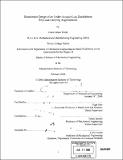| dc.contributor.advisor | Hugh Herr and Derek Rowell. | en_US |
| dc.contributor.author | Walsh, Conor James | en_US |
| dc.contributor.other | Massachusetts Institute of Technology. Dept. of Mechanical Engineering. | en_US |
| dc.date.accessioned | 2007-01-10T16:55:53Z | |
| dc.date.available | 2007-01-10T16:55:53Z | |
| dc.date.copyright | 2006 | en_US |
| dc.date.issued | 2006 | en_US |
| dc.identifier.uri | http://hdl.handle.net/1721.1/35648 | |
| dc.description | Thesis (S.M.)--Massachusetts Institute of Technology, Dept. of Mechanical Engineering, 2006. | en_US |
| dc.description | Includes bibliographical references (leaves 79-81). | en_US |
| dc.description.abstract | Metabolic studies have shown that there is a metabolic cost associated with carrying a load (Griffin et al, 2003). Further studies have shown that by applying forward propulsive forces a person can walk with a reduced metabolic rate (Farley & McMahon, 1992 and Gottschall & Kram, 2003). Previous work on exoskeleton design has not considered the passive dynamics of walking and has focused on fully actuated systems that are inefficient and heavy. In this thesis, an under-actuated exoskeleton is presented that runs parallel to the human leg. The exoskeleton component design is based on the kinematics and kinetics of human walking. The joint components of the exoskeleton in the sagittal plane consist of a force-controllable actuator at the hip, a variable-damper mechanism at the knee and a passive spring at the ankle. A state-machine control strategy is written based on joint angle and ground-exoskeleton force sensing. Positive, non-conservative power is added at the hip during the walking cycle to help propel the mass of the human and payload forward. At the knee, the damper mechanism is turned on at heel strike as the exoskeleton leg is loaded and turned off during terminal stance to allow knee flexion. | en_US |
| dc.description.abstract | (cont.) The spring at the ankle engages in controlled dorsiflexion to store energy that is later released to assist in powered plantarflexion. Kinetic and metabolic data are recorded from human subjects wearing the exoskeleton with a 751b payload. These data are compared to data recorded from subjects walking without the exoskeleton. It is demonstrated that the exoskeleton does transfer loads to the ground with a 90% and higher load transfer depending on the phase of gait. Further, exoskeleton wearers report that the exoskeleton greatly reduces the stress on the shoulders and back. However, although a significant fraction of the payload is transferred through the exoskeleton structure, the exoskeleton is found to increase metabolic economy by 74%. By comparing distinct exoskeleton configurations, the relative effect of each exoskeleton component is determined. Metabolic data show that the variable-damper knee and ankle spring mechanisms increase metabolism by only 32%, whereas a non-actuated exoskeleton (no motor, variable-damper, or spring) increases walking metabolism by 62%. These results highlight the benefit of ankle elastic energy storage and knee variable-damping in exoskeleton design, and further the need for a lighter, more efficient hip actuator. | en_US |
| dc.description.statementofresponsibility | by Conor James Walsh. | en_US |
| dc.format.extent | 88 leaves | en_US |
| dc.format.extent | 5205559 bytes | |
| dc.format.extent | 5496284 bytes | |
| dc.format.mimetype | application/pdf | |
| dc.format.mimetype | application/pdf | |
| dc.language.iso | eng | en_US |
| dc.publisher | Massachusetts Institute of Technology | en_US |
| dc.rights | M.I.T. theses are protected by copyright. They may be viewed from this source for any purpose, but reproduction or distribution in any format is prohibited without written permission. See provided URL for inquiries about permission. | en_US |
| dc.rights.uri | http://dspace.mit.edu/handle/1721.1/7582 | |
| dc.subject | Mechanical Engineering. | en_US |
| dc.title | Biomimetic design for an under-actuated leg exoskeleton for load-carrying augmentation | en_US |
| dc.type | Thesis | en_US |
| dc.description.degree | S.M. | en_US |
| dc.contributor.department | Massachusetts Institute of Technology. Department of Mechanical Engineering | |
| dc.identifier.oclc | 76756862 | en_US |
